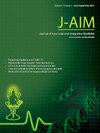来自石榴皮提取物的生物活性化合物的硅对接分析:接近卵巢癌的精确解决方案
IF 1.9
Q3 INTEGRATIVE & COMPLEMENTARY MEDICINE
引用次数: 0
摘要
MAPK信号通路,特别是那些涉及EGFR和VEGFR的信号通路,在卵巢癌的发生和发展中起着关键作用。这些途径的调节不足可能导致不受控制的细胞增殖、血管生成和转移。靶向丝裂原活化蛋白激酶(MAPKs),包括表皮生长因子受体(EGFR)和血管内皮生长因子受体(VEGFR),已经显示出抑制癌细胞增殖和血管生成的巨大潜力,在各种治疗策略中代表了一个有前途的途径。目的探讨石榴皮提取物麻石用于卵巢癌治疗的可能性,特别是针对MAPKs (EGFR和VEGFR)。石榴(石榴)是一种众所周知的水果,其不同的部分已经在传统医学中使用了很长时间。材料与方法采用Autodock 4.2.6软件对石榴皮提取物中提取的活性物质进行硅对接。利用Pubchem site共生成了10个二维配体。靶蛋白VEGFR、EGFR、MAPK和MAPK8与从石榴皮提取物中鉴定出的生物活性成分配体(Sphondin、Isorhamnetin、Lupinine、鞣花酸和柠檬酸)对接。结果mapk8、mapk14和VGFR蛋白与鞣花酸配体的结合能分别为-8.25kcal/mol、-7.61kcal/mol和- 5.85kcal/mol。然而,EGFR以-7.48kcal/mol的速率与异鼠李素结合。结论MAPK信号通路,特别是EGFR和VEGFR,在卵巢癌的发生和传播中起着至关重要的作用。这些通路的失调可导致无限制的细胞增殖、血管生成和转移。我们的研究揭示了靶蛋白和配体之间有利的结合能。因此,我们推断,与石榴皮提取物中生物活性化合物具有强大结合能的蛋白质可能对信号通路施加调节控制。这表明EGFR和VEGFR可以通过与石榴皮提取物中的生物活性化合物结合来调节信号,从而调节MAPK通路,最终抑制不受控制的细胞增殖、血管生成和肿瘤转移。得到仿真研究结果的支持。本文章由计算机程序翻译,如有差异,请以英文原文为准。
In-silico docking analysis of bioactive compounds sourced from Punica granatum peel extract: Approaching a precision solution for ovarian cancer
Background
The MAPK signalling pathways, particularly those involving EGFR and VEGFR, play a pivotal role in the initiation and progression of ovarian cancer. Inadequate regulation of these pathways may lead to uncontrolled cell proliferation, angiogenesis, and metastasis. Targeting mitogen-activated protein kinases (MAPKs), including the epidermal growth factor receptor (EGFR) and vascular endothelial growth factor receptor (VEGFR), has demonstrated significant potential in restraining cancer cell proliferation and angiogenesis, representing a promising avenue among various therapeutic strategies.
Objectives
This manuscript aims to investigate the possibility of Mashi a pomegranate peel extract for ovarian cancer treatment, specifically targeting MAPKs (EGFR and VEGFR). Pomegranate (Punica granatum) is a well-known fruit whose varied portions have been used in traditional medicine for ages.
Materials and methods
In silico docking of bioactive compounds extracted from the pomegranate peel extract was done using the Autodock 4.2.6 software. A total of 10 two-dimensional ligands were generated with Pubchem site. The targeted proteins VEGFR, EGFR, MAPK, and MAPK8 were docked with the ligands (Sphondin, Isorhamnetin, Lupinine, Ellagic acid, and Citric acid) which were bioactive ingredients identified from pomegranate peel extract.
Results
It was observed that the binding energy of protein MAPK 8, MAPK 14, and VGFR was higher to the ligand at ellagic acid at -8.25kcal/mol, -7.61kcal/mol, and - 5.85kcal/mol respectively. However, EGFR observed to bind with ligand Isorhamnetin at -7.48kcal/mol.
Conclusion
The MAPK signalling pathways, specifically involving EGFR and VEGFR, play a crucial role in the initiation and dissemination of ovarian cancer. Dysregulation of these pathways can lead to unrestrained cell proliferation, angiogenesis, and metastasis. Our study revealed favorable binding energy between targeted proteins and ligands. Consequently, we infer that proteins exhibiting robust binding energy with bioactive compounds from pomegranate peel extract may exert regulatory control over the signalling pathways. This implies that EGFR and VEGFR can modulate signals by binding to the bioactive compounds in pomegranate peel extract, thereby regulating the MAPK pathway and ultimately curtailing uncontrolled cell proliferation, angiogenesis, and tumor metastasis. supported by simulation studies results.
求助全文
通过发布文献求助,成功后即可免费获取论文全文。
去求助
来源期刊

Journal of Ayurveda and Integrative Medicine
INTEGRATIVE & COMPLEMENTARY MEDICINE-
CiteScore
4.70
自引率
12.50%
发文量
136
审稿时长
30 weeks
 求助内容:
求助内容: 应助结果提醒方式:
应助结果提醒方式:


